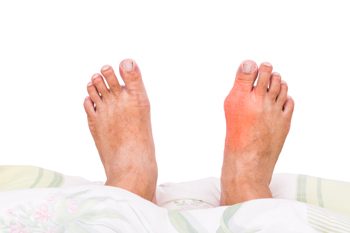
Kevin F Gallagher, DPM
Board Certified in Foot and Ankle Surgery
(724) 941-4330

Kevin F Gallagher, DPM
Board Certified in Foot and Ankle Surgery
(724) 941-4330
 Bunionettes, also known as Tailor’s bunions, are bony protrusions at the base of the little toe on the outside of the foot. Like bunions, bunionettes are a deformity that can cause discomfort and pain when anything rubs against them. Bunionettes are usually caused by wearing shoes that constrict the foot, such as high heels or shoes with pointed toes. They can also be caused by genetics, arthritis, or a misalignment of the foot. Treatments for this condition include wearing comfortable, supportive shoes with wide toe boxes and wearing special pads that reduce pain from the bunionette. In very severe cases, surgery may be needed to remove the bunionette or to realign the bone of the pinky toe. If you suffer from bunionettes, it is suggested that you see a podiatrist for treatment.
Bunionettes, also known as Tailor’s bunions, are bony protrusions at the base of the little toe on the outside of the foot. Like bunions, bunionettes are a deformity that can cause discomfort and pain when anything rubs against them. Bunionettes are usually caused by wearing shoes that constrict the foot, such as high heels or shoes with pointed toes. They can also be caused by genetics, arthritis, or a misalignment of the foot. Treatments for this condition include wearing comfortable, supportive shoes with wide toe boxes and wearing special pads that reduce pain from the bunionette. In very severe cases, surgery may be needed to remove the bunionette or to realign the bone of the pinky toe. If you suffer from bunionettes, it is suggested that you see a podiatrist for treatment.
If you are suffering from bunions, contact Dr. Kevin F. Gallagher of Gallagher Podiatry. Our doctor can provide the care you need to keep you pain-free and on your feet.
What Is a Bunion?
A bunion is formed of swollen tissue or an enlargement of boney growth, usually located at the base joint of the toe that connects to the foot. The swelling occurs due to the bones in the big toe shifting inward, which impacts the other toes of the foot. This causes the area around the base of the big toe to become inflamed and painful.
Why Do Bunions Form?
Genetics – Susceptibility to bunions are often hereditary
Stress on the feet – Poorly fitted and uncomfortable footwear that places stress on feet, such as heels, can worsen existing bunions
How Are Bunions Diagnosed?
Doctors often perform two tests – blood tests and x-rays – when trying to diagnose bunions, especially in the early stages of development. Blood tests help determine if the foot pain is being caused by something else, such as arthritis, while x-rays provide a clear picture of your bone structure to your doctor.
How Are Bunions Treated?
If you have any questions, please feel free to contact one of our offices located in McMurray and Hickory, PA . We offer the newest diagnostic and treatment technologies for all your foot care needs.